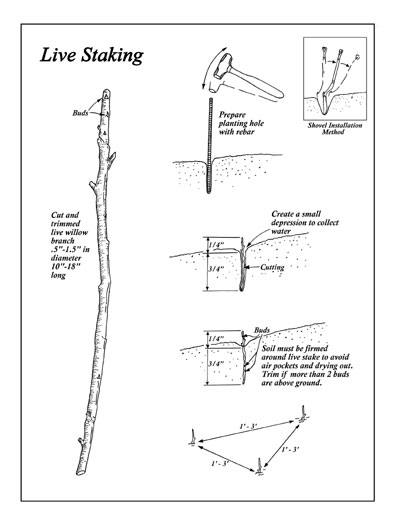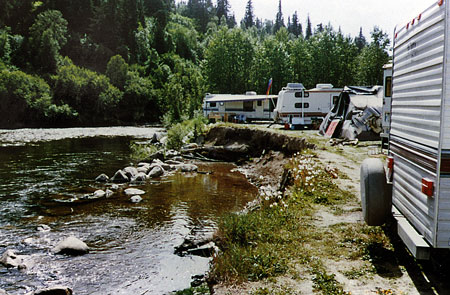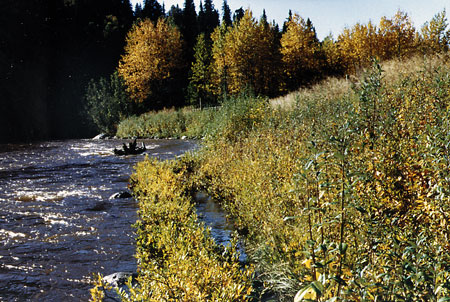Streambank Revegetation and Protection: A Guide for Alaska
Revegetation Techniques: Live Staking
Live staking is a simple technique that installs a dormant cutting directly into the ground. This technique is often utilized where single stem plantings will provide adequate plant cover, slope stability and fish habitat. Live staking should be combined with other revegetation techniques; these may include anchoring bundles, brush mats and erosion control fabric.
Collection, storage and planting information is described under Dormant Cuttings.
Prepare several live stakes from one dormant cutting. Cut stakes 10 to 18 inches long, 1/2 to 2 inches in diameter (slightly larger diameter cuttings will also work). Discard flower buds ("pussy willows"). Flower buds typically occur at the top 2/3 of a branch that was produced during the past growing season. At least one or two leaf buds that are smaller than flower buds must be present near the top of each live stake.
Select planting sites carefully since live stakes require moist soils. The bottom 6 inches needs to be in permanently moist soils. If planted on drier slopes, survivability will decrease. Watering could increase survival and promote plant growth. Occasional deep watering is more effective and encourages deeper rooting than frequent light watering. Water during the first 6 weeks after planting if in non-permanently moist soil.
Use rebar, 3/4 inch or less in diameter, to create a planting hole for longer stakes, particularly when planting in compact and gravelly soils. A shovel or hydraulic drill may also be used. Tightly pack the soil around the stake so that no air pockets remain.
Plant stakes upright 1 to 3 feet on center. Stakes should be planted as vertically as possible, placing at least 3/4 of the stake below ground so that only one or two leaf buds are left exposed above the ground. The intent is to maximize the surface area for rooting so a good root system can develop and support a healthy shoot system. If more than one or two buds, 1/4 of the stake, or 4 inches of the live stake is extending above the soil surface, trim the stake.
Water to help remove air pockets and increase contact between the soil and surface of the live stake. Moist soil is needed during the period the live stake is rooting and becoming established, at least 4 to 6 weeks after planting. Topsoil is not required. Survival rates for drier sites may be increased if larger cuttings are used along with increased watering.
Advantages:
- Inexpensive
- Not labor intensive
- Low tech
- May plant in high densities
Disadvantages:
- Low survival compared with other revegetation techniques discussed
- Should be used in conjunction with other revegetation techniques
- Ease of planting is dependant on soil type and site condition
- Should only be used at sites with moist soils, or prepare to water extensively



